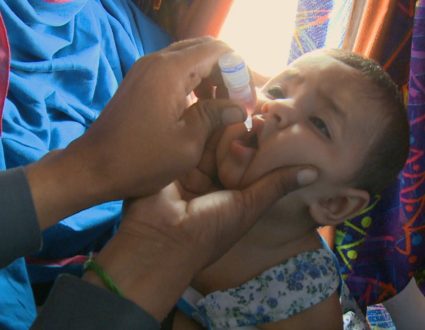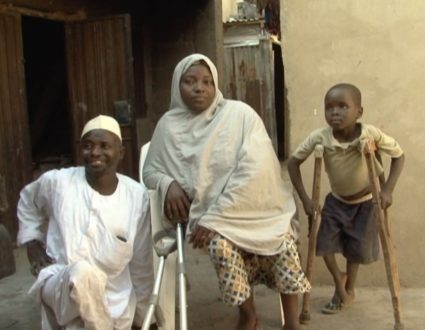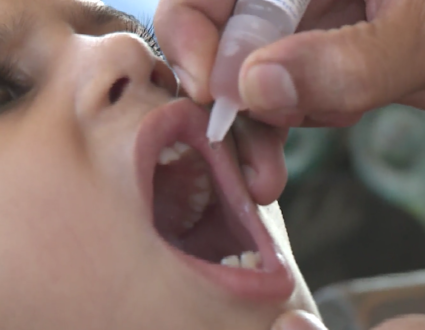Challenges Remain
Health officials in India are close to wiping out polio, a disease forgotten in most of the world but still endemic in some developing countries. Special correspondent Fred de Sam Lazaro reports on India’s challenge to remain vigilant in its campaign to immunize children one mouthful at a time.
JEFFREY BROWN: And next to India, a poor and populous country long plagued by polio, but now health officials have come close to wiping out the disease. Special correspondent Fred de Sam Lazaro explains how that was accomplished.
FRED DE SAM LAZARO: In India, the battle against polio is being fought one mouthful at a time. Vaccinators have fanned out with coolers containing vials of the oral vaccine on a scale befitting a nation of 1.2 billion, says Lieven Desomer, a campaign strategist for the U.N.
LIEVEN DESOMER, UNICEF: One national round, we reach almost 75 million children, 150,000 supervisors, 1.2 million vaccinated.
FRED DE SAM LAZARO: They look for families especially at bus and train stations in the populous northern states, where polio is most endemic.
They look for young children, making sure first to check their pinkie fingers, where an indelible ink is placed once a child is immunized.
Thousands of times, with little fuss, each vaccinator has administered the two-drop dose of vaccine. As a result, India, one of four countries where polio is still endemic, may soon become free of it.
It’s easier to see how India can be a breeding ground for polio. Hundreds of millions of people lack proper sanitation, conditions that allow the virus to spread, usually attacking children, causing paralysis in some victims and in a few cases death.
In addition, it’s difficult for public health workers to track the movements of India’s huge nomadic and migrant populations. On any given day, 19 million people are on a train somewhere in India. That’s why experts say the huge drop in polio cases — they were up to 150,000 a year in the ’80s — is remarkable.
As recently as 2009, there were 741 cases of polio in India, more than any other nation. By last year, 2011, the number had dwindled to one solitary case, what campaigners hope will be the last one they will ever find in India.
LIEVEN DESOMER: I have to pinch myself once in a while to really realize that we actually — we’re almost there. And, for me, it’s amazing being here, because it’s part of history. We are making history here.
FRED DE SAM LAZARO: Desomer is with UNICEF, with, along the World Health Organizations, the U.S. Centers for Disease Control and Rotary International, partnered with the Indian government in the multi-year $2 billion-plus campaign.
He says a few years ago, many impoverished communities resisted the vaccine.
LIEVEN DESOMER: These were communities which have not benefited from all the progress in India. And they have no roads, no clean sanitation. And they would usually campaign to say, you can reach us with a drop of vaccine. Why can’t you reach us with education and health and good water and sanitation? So, that is one thing.
FRED DE SAM LAZARO: So they were suspicious?
LIEVEN DESOMER: They were quite suspicious.
FRED DE SAM LAZARO: Suspicion that the vaccine wasn’t what was claimed was particularly high among India’s Muslim minority.
Mufti Mukarram Ahmed, imam of the Fatehpuri Mosque in substantially Muslim Old Delhi, says memories are still vivid of coercive attempts by the government in the ’70s to sterilize people here.
MUFTI MUKARRAM AHMED, Imam (through translator): People thought that in the polio vaccine, they placed some medicine to sterilize people. They think that just like in the time of Sanjay Gandhi, when sterilization operations were going on, they think now, instead of doing operations, they can just give this medicine to the Muslim community and our men and women will not be able to have children.
FRED DE SAM LAZARO: He was among many religious leaders who were approached by doctors and the U.N. agencies, reassured of their intentions, and brought on board to endorse the polio campaign.
Also coaxed in were Bollywood megastars like Amitabh Bachchan. In this TV spot, he angrily tell parents to put aside excuses like the fear of caste or religious discrimination and immunize their children.
AMITABH BACHCHAN, actor (through translator): Have you lost your mind?
FRED DE SAM LAZARO: His co-star in the ad, Shahrukh Khan, is Muslim.
SHAHRUKH KHAN, actor (through translator): His anger is justified. What’s the connection between caste or religion and polio? Any child can get this disease. That’s why I too have vaccinated my kids against polio. Now you please go and do the same.
FRED DE SAM LAZARO: Perhaps the most significant buy-in that helped the polio campaign came from the government at all levels, according to this Dr. Hamid Jafari with the World Health Organization.
DR. HAMID JAFARI, World Health Organization: The government of India has funded the largest chunk of this program, you know, up to $250 million each year, which is unprecedented compared to other countries.
FRED DE SAM LAZARO: The government declared that any polio virus citing must be treated as a public health emergency. Jafari says that allowed for vigorous surveillance and response. Old reports of paralysis in children were investigated.
DR. HAMID JAFARI: In 2011, nearly 60,000 cases of acute flaccid paralysis were reported and investigated. And only one of those cases, the one that had onset on Jan 13., we were able to isolate polio viruses — virus. The other cases were due to non-polio causes of acute flaccid paralysis. So that tells you how sensitive the civilian system is.
And there are international standards. And those standards are now being exceeded.
FRED DE SAM LAZARO: He says the big lesson from India for Nigeria, Afghanistan and Pakistan, three other countries where the virus is endemic, is that polio here became a huge, widely publicized national cause, much more than a public health campaign.
DR. HAMID JAFARI: You’re talking about community leaders, religious leaders, academic leaders, opinion leaders, so just getting — really turning it into sort of a national movement, so that everybody feels that they are part of this movement.
It’s not only just the health department that has to deliver on this. And I think that’s the kind of tipping point for Nigeria and Pakistan. I mean, these two countries have done a lot of good work and have made a lot of progress. It’s what it is going to take to bring them to the tipping point where India is now.
FRED DE SAM LAZARO: For India, the challenge is to remain vigilant and polio free for two more years to officially fall off the list of endemic countries.
Government officials say they next want to use the polio system and teams to tackle other relatively neglected diseases, like measles. Longer-term, the challenge is to build basic sanitation and education systems, things that can prevent disease in the first place.
Fred’s reporting is a partnership with the Under-Told Stories Project at Saint Mary’s University in Minnesota.

Targeting Transit
It’s difficult for public health workers to track the movements of India’s huge nomadic and migrant populations. On any given day, 19 million people are on a train somewhere in India. Polio workers look for families especially at bus and train stations in the populous northern states, where polio is most endemic.

Polio’s Breeding Ground
Hundreds of millions of people lack proper sanitation, conditions that allow the virus to spread, usually attacking children, causing paralysis in some victims and in a few cases death.
LIEVEN DESOMER
“These were communities which have not benefited from all the progress in India. And they have no roads, no clean sanitation. And they would usually campaign to say, you can reach us with a drop of vaccine. Why can’t you reach us with education and health and good water and sanitation? So, that is one thing.”




